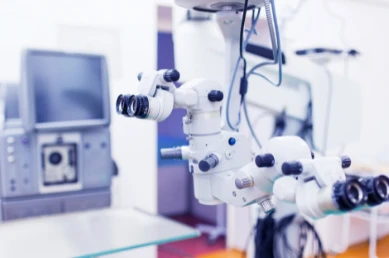Eyes Of The Future
personalEYES | 6 Jun 2019

Bionic eyes might sound like something out of science fiction. Along with robot butlers, flying cars and time machines, bionic eyes exist purely in the imagination, awaiting a more technically developed world. Or so we thought.
As it turns out, a form of bionic eye has been developed, and has restored some level of sight to over 20 people in Europe. Developed by Robert Greenberg, the chief executive of Second Sight Medical Products Inc., and his team of engineers, the Argus II Retinal Prosthesis System took 20 years and around $200 million to build. It is now enjoying global success, having been approved for sale in the United States.
Though it costs around $100,000, in the European Union most patients had their costs covered by insurance companies. Whether that happens in the US remains to be seen.
A new view
Unfortunately for those hoping for superhuman sight or x-ray vision, the Argus II isn’t designed to heighten normal eyesight. But what it does do is even more miraculous; it restores some sight to people rendered blind by retinitis pigmentosa.
This inherited, degenerative eye disease affects around 1 in 4,000 people. Symptoms can occur at any time, with some people suffering effects at birth, and others not until much later in life. Though there is no steady progression, if sufferers reach the advanced stage, the result is always the same – blindness.
The Argus II helps to reverse this loss of sight. Though it doesn’t completely restore sight, it allows users to perceive boundaries a borders. This might not sound like much to those of us with normal vision, but to someone who is blind, this is a great leap forward.
Implants and images
The Argus II is an electronic retinal implant that works in conjunction with an eyeglass mounted camera. The camera records images in real time, and sends them wirelessly to the retinal implant. The implant uses this information to activate the user’s remaining healthy retinal cells, stimulating them with 60 electrodes. The cells then send this information to the optic nerve, allowing someone fitted with the device to discern both movement and light.
Interestingly, although it does restore sight, it does not actually cure blindness. The World Health Organisation defines blindness as visual acuity with a score greater than 20/500. The Argus II improves vision to 20/1260, which is considered clinically blind. Despite this, even this small improvement will be beneficial to those living with absolutely no sight.
Seeing the World
In March 2011, the Argus II was approved for clinical and commercial use in the European Union. In March of this year, it received approval in the United States.
Though there has been no word on what other markets it will be released to, perhaps Australia will be next. If that’s the case, eye surgeons nationwide might find themselves in even greater demand, installing retinal implants to restore sight.
.jpg)
-mobile.jpg)
.webp)
